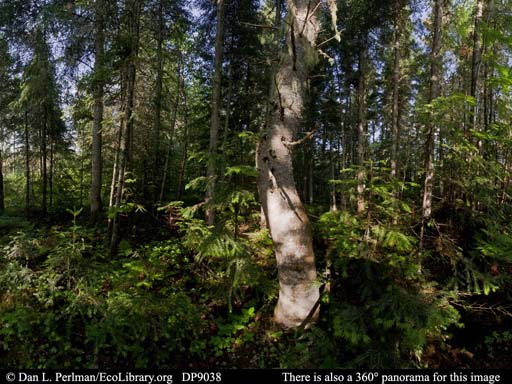Panorama: boreal forest
| Title | Info |
|---|---|
| Common name | Spruce; Fir |
| Scientific name | Picea; Abies |
| Taxonomic group | Pinaceae |
| Source | Dan L. Perlman |
| Ecosystems | Forests |
| Forests | Boreal forest or taiga |
| Conservation | Nature preserves |
| Lessons | Panoramas |
| Date | June 27, 2007 |
| Location | Forêt Montmorency,Québec,Canada,North America |

Related materials: Panoramas
You may want to discuss with your students the vast changes that this ecosystem experiences over the course of a year. At this time of year, the forest is full of activity, with birds and insects everywhere, and herbs bursting from the forest floor. Most of the year, however, this forest is too cold and snow-covered for most of these organisms to be present and active. Consider, too, the many adaptations that the conifers of this forest exhibit -- especially adaptations that help them deal with winter.
Panorama Viewing: Click the "View Panorama" button to see an interactive panorama. Click and drag your mouse in any direction to view other parts of the scene; press the Shift key to zoom in to see details and press Ctrl to zoom out.
We recommend using the Deval VR viewer for seeing panoramas that do NOT have sound and the QuickTime viewer for panoramas WITH sound.
Panorama Viewing: Click the "View Panorama" button to see an interactive panorama. Click and drag your mouse in any direction to view other parts of the scene; press the Shift key to zoom in to see details and press Ctrl to zoom out.
We recommend using the Deval VR viewer for seeing panoramas that do NOT have sound and the QuickTime viewer for panoramas WITH sound.
The boreal forest (or taiga) circles the Northern Hemisphere just south of the tundra biome, stretching across vast expanses of Europe, Asia, and North America. The plants and animals of these forests have adapted to very long, cold winters and a very short (but sun-filled) growing season. As can be seen in this panorama, most of the trees in the boreal forest are conifers, such as spruces, firs, and larches.